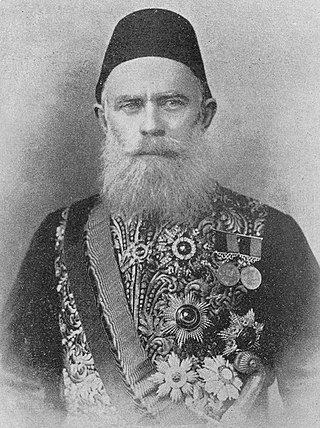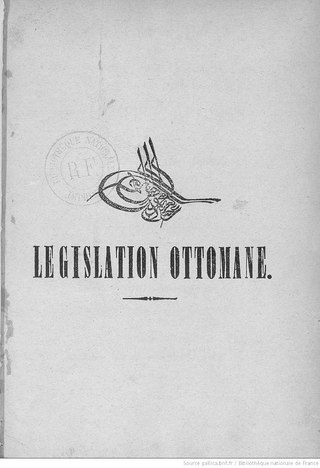A fatwa is a legal ruling on a point of Islamic law (sharia) given by a qualified Islamic jurist (faqih) in response to a question posed by a private individual, judge or government. A jurist issuing fatwas is called a mufti, and the act of issuing fatwas is called ifta'. Fatwas have played an important role throughout Islamic history, taking on new forms in the modern era.

The Ottoman Empire, historically and colloquially known as the Turkish Empire, was an imperial realm that spanned much of Southeast Europe, West Asia, and North Africa from the 14th to early 20th centuries; it also controlled parts of southeastern Central Europe between the early 16th and early 18th centuries.
Sharia is a body of religious law that forms a part of the Islamic tradition based on scriptures of Islam, particularly the Quran and hadith. In Arabic, the term sharīʿah refers to God's immutable divine law and this referencing is contrasted with fiqh, which refers to its interpretations by Islamic scholars. Fiqh, practical application side of sharia in a sense, was elaborated over the centuries by legal opinions issued by qualified jurists and sharia has never been the sole valid legal system in Islam historically; it has always been used alongside customary law from the beginning, and applied in courts by ruler-appointed judges, integrated with various economic, criminal and administrative laws issued by Muslim rulers.

In Islam, the ulama, also spelled ulema, are scholars of Islamic doctrine and law. They are considered the guardians, transmitters, and interpreters of religious knowledge in Islam.

The Tanzimat was a period of reform in the Ottoman Empire that began with the Gülhane Hatt-ı Şerif in 1839 and ended with the First Constitutional Era in 1876. The Tanzimat era began with the purpose not of radical transformation, but of modernization, desiring to consolidate the social and political foundations of the Ottoman Empire. It was characterised by various attempts to modernise the Ottoman Empire and to secure its territorial integrity against internal nationalist movements and external aggressive powers. The reforms encouraged Ottomanism among the diverse ethnic groups of the Empire and attempted to stem the rise of nationalism in the Ottoman Empire.
The Ottoman Empire developed over the years as a despotism with the Sultan as the supreme ruler of a centralized government that had an effective control of its provinces, officials and inhabitants. Wealth and rank could be inherited but were just as often earned. Positions were perceived as titles, such as viziers and aghas. Military service was a key to many problems.

The Gülhane Hatt-ı Şerif or Tanzimât Fermânı was a proclamation by Ottoman Sultan Abdülmecid I in 1839 that launched the Tanzimât period of reforms and reorganization in the Ottoman Empire. The 125th anniversary of the edict was depicted on a former Turkish postcard stamp.
In the Ottoman Empire, a millet was an independent court of law pertaining to "personal law" under which a confessional community was allowed to rule itself under its own laws.

Ahmed Cevdet Pasha or Jevdet Pasha in English was an Ottoman scholar, intellectual, bureaucrat, administrator, and historian who was a prominent figure in the Tanzimat reforms of the Ottoman Empire. He was the head of the Mecelle commission that codified Islamic law for the first time in response to the Westernization of law. He is often regarded as a pioneer in the codification of a civil law based on the European legal system. The Mecelle remained intact in several modern Arab states in the early and mid-20th-century. In addition to Turkish, he was proficient in Arabic, Persian, French and Bulgarian. He wrote numerous books on history, law, grammar, linguistics, logic and astronomy.
Atatürk's Reforms were a series of political, legal, religious, cultural, social, and economic policy changes, designed to convert the new Republic of Turkey into a secular nation-state, implemented under the leadership of Mustafa Kemal Atatürk in accordance with the Kemalist framework. His political party, the Republican People's Party (CHP), ran Turkey as a one-party state and implemented these reforms, starting in 1923. After Atatürk's death, his successor İsmet İnönü continued the one-party rule and Kemalist style reforms until the CHP lost to the Democrat Party in Turkey's second multi-party election in 1950.

The Imperial Reform Edict was a February 18, 1856 edict of the Ottoman government and part of the Tanzimat reforms. The decree from Ottoman Sultan Abdulmejid I promised equality in education, government appointments, and administration of justice to all regardless of creed. The decree is often seen as a result of the influence of France and Britain, which assisted the Ottoman Empire against the Russians during the Crimean War (1853–1856) and the Treaty of Paris (1856) which ended the war.

The Mecelle-i Ahkâm-ı Adliye, or the Mecelle in short, was the civil code of the Ottoman Empire in the late 19th and early 20th century. It is the first codification of Sharia law by an Islamic nation.

The Constitution of the Ottoman Empire was the first and only constitution of the Ottoman Empire. Written by members of the Young Ottomans, particularly Midhat Pasha, during the reign of Sultan Abdul Hamid II, the constitution was in effect from 1876 to 1878 in a period known as the First Constitutional Era, and from 1908 to 1922 in the Second Constitutional Era. After Abdul Hamid's political downfall in the 31 March Incident, the Constitution was amended to transfer more power from the sultan and the appointed Senate to the popularly-elected lower house: the Chamber of Deputies.

In the Ottoman Empire, women enjoyed a diverse range of rights and were limited in diverse ways depending on the time period, as well as their religion and class. The empire, first as a Turkoman beylik, and then a multi-ethnic, multi-religious empire, was ruled in accordance to the qanun, the semi-secular body of law enacted by Ottoman sultans. Furthermore, the relevant religious scriptures of its many confessional communities played a major role in the legal system, for the majority of Ottoman women, these were the Quran and Hadith as interpreted by Islamic jurists, often termed sharia. Most Ottoman women were permitted to participate in the legal system, purchase and sell property, inherit and bequeath wealth, and participate in other financial activities, rights which were unusual in the rest of Europe until the 19th century.
A kadi was an official in the Ottoman Empire. In Arabic, the term qāḍī typically refers to judges who preside over matters in accordance with sharia Islamic law; under Ottoman rule, however, the kadi also became a crucial part of the imperial administration. After Mehmed II codified his Kanun, kadis relied on this dynastic secular law, local customs, and sharia to guide their rulings. Along with adjudicating over criminal and civil matters, the kadi oversaw the administration of religious endowments and was the legal guardian of orphans and others without a guardian. Although Muslims, in particular Muslim men, possessed a higher status in the kadi's court, non-Muslims and foreigners also had access to the judicial system. Under the Ottomans' initial system of feudal land grants, the timar system, the kadi served as an important check on the power of the local and regional military lords. Despite the unquestioned authority of the sultan, kadis possessed a certain degree of autonomy in their rulings.

The language of the court and government of the Ottoman Empire was Ottoman Turkish, but many other languages were in contemporary use in parts of the empire. The Ottomans had three influential languages, known as "Alsina-i Thalātha", that were common to Ottoman readers: Ottoman Turkish, Arabic and Persian. Turkish was spoken by the majority of the people in Anatolia and by the majority of Muslims of the Balkans except in Albania, Bosnia, and various Aegean Sea islands; Persian was initially a literary and high-court language used by the educated in the Ottoman Empire before being displaced by Ottoman Turkish; and Arabic, which was the legal and religious language of the empire, was also spoken regionally, mainly in Arabia, North Africa, Mesopotamia and the Levant.
Sharia means Islamic law based on age-old concepts. Since the early Islamic states of the eighth and ninth centuries, Sharia always existed alongside other normative systems.
Qanun is an Arabic term that refers to laws established by Muslim sovereigns, especially the body of administrative, economic and criminal law promulgated by Ottoman sultans. It is used to contrast with sharia, the body of law elaborated by Muslim jurists. It is thus frequently translated as "dynastic law."
The Ilmiye is one of four institutions that existed within the state organisation of the Ottoman Empire, the other three being the Imperial (mülkiye) institution; the military (seyfiye) institution; and the administrative (kalemiye) institution. The function of the Ilmiye was to propagate the Muslim religion, to ensure that Islamic law was enforced properly within the courts, as well as to ensure that it was interpreted and taught properly within the Ottoman school system. The development of the Ilmiye took place over the course of the sixteenth century, absorbing the Ulama, the educated class of Muslim legal scholars, in the process.
Beginning in the latter half of the 19th century, the Nizamiye Courts were a secular court system introduced within the Ottoman Empire during the Tanzimat era. This court system was administered under the Ottoman Ministry of Justice. Although secular, the Mecelle was eventually applied to the courts. This court system drew much influence from French models at the time. These courts enabled the further growth of legal pluralism within Ottoman jurisprudence.












